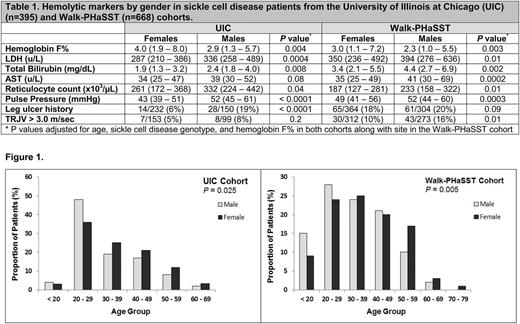Abstract
Sickle cell disease (SCD) is an inherited erythrocyte disorder characterized by chronic hemolysis and vasculopathy. Females have reduced levels of hemolysis compared to males in both the general population (Jordan A et al, Vox Sang 2016) as well as in SCD (Kanias T et al, Transfusion 2016). This phenomenon may be due to the effects of gender on hemoglobin (Hb) F levels (Dover GJ et al, Blood 1992), red blood cell membrane stability (Jordan A et al, Vox Sang 2016), and nitric oxide (NO) bioavailability (Gladwin MT et al, Circulation 2003). We wished to confirm reduced hemolysis in SCD females and whether this would be associated with reduced hemolytic complications, some of which are associated with mortality. Finally, we wished to see if there were suggestions of improved survival in females compared to males with SCD.
We investigated differences in laboratory and clinical features by gender in 395 (155 male, 240 female) SCD patients treated at the University of Illinois at Chicago (UIC) and in 668 (304 male, 364 female) SCD patients from the multicenter Walk-PHaSST cohort. Comparisons of linear and categorical variables were performed using ANOVA and logistic regression analysis, respectively adjusting for age, SCD genotype, and Hb F levels. Median values and interquartile range (IQR) are provided.
In SCD patients either not on hydroxyurea or with Hb F levels available prior to initiating hydroxyurea, we observed higher Hb F values in females vs. males from both the UIC (n=329, P=0.004) and Walk-PhaSST (n=368, P=0.003) cohorts (Table 1). Hemolytic markers were lower in females vs. males and these relationships persisted after adjusting for HbF levels, including LDH (UIC: P=0.0004, Walk-PHaSST: P=0.01); total bilirubin (UIC: P=0.008; Walk-PHaSST: P=0.002), AST (UIC: P=0.08; Walk-PHaSST: P=0.0002), and absolute reticulocyte count (UIC: P=0.04, Walk-PHaSST: P=0.01) (Table 1).
Less hemolysis would be expected to decrease the occurrence or severity of a hemolytic vasculopathy and its manifestations. Pulse pressures were lower in females than males in both cohorts (UIC: P <0.0001; Walk-PHaSST: P=0.0003). Additional manifestations less frequently observed in females than males included leg ulcer history (UIC: P<0.0001; Walk-PHaSST: P=0.09) and tricuspid regurgitant velocity >3.0m/s (UIC: P=0.2; Walk-PHaSST: P=0.01)(Table 1). The degree of hemolysis is an independent predictor for early mortality in SCD (Kato GJ et al, Blood 2006, Nouriae M et al, Haematologica 2013). There were progressively higher ratios of females:males with increasing age in SCD patients (Cochran's linear trend; UIC: P=0.03, Walk-PHaSST: P=0.005) (Figure 1).
We compared gene expression in peripheral blood mononuclear cells by gender in 180 SCD patients from UIC using the Affymetrix Human Exon 2.0 ST array. Restricting analyses to autosomes with an FDR < 0.05, no statistically significant differences in gene expression were observed. We also determined the X-linked G6PD A- status by PCR in 259 SCD patients from the UIC cohort. G6PD A- deficiency was observed in 4% (6/155) of females and 10% (10/104) of males and was not associated with hemolytic markers.
In summary, females had a lower degree of hemolysis, decreased vasculopathy, and represented a progressively higher proportion of SCD patients with increasing age in both the UIC and Walk-PHaSST cohorts. Future investigation of loci on the sex chromosomes for effects on Hb F levels and the degree of hemolysis are warranted. Understanding the mechanisms for reduced hemolysis in women with SCD, such as the potential effects of testosterone and estrogen on erythrocyte membrane stabilization, may also help guide future therapies.
No relevant conflicts of interest to declare.
Author notes
Asterisk with author names denotes non-ASH members.


This feature is available to Subscribers Only
Sign In or Create an Account Close Modal